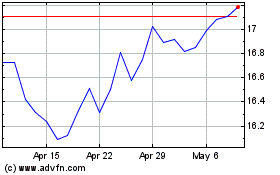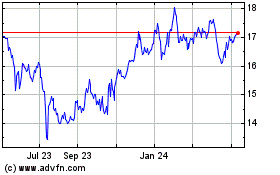Coronavirus Quarantine Boosts Streaming Video, but Not Advertising Yet
March 26 2020 - 5:59AM
Dow Jones News
By Sahil Patel
People are spending more time streaming video as the novel
coronavirus forces them to stay indoors. Advertisers, however,
aren't following the same trajectory.
TV streaming time in the U.S. went up 12% last week compared
with the previous week, according to video technology company Wurl
Inc., which says it tracks viewing habits of about 5 million
viewers on internet-connected TV sets.
Amazon.com Inc. and Walt Disney Co.'s Hulu have seen streaming
go up during the crisis, according to people familiar with the
matter. Other streaming video providers including AT&T Inc.'s
HBO and Vizio Inc. have reported increased viewing on their
streaming services as well.
Viewers seem particularly motivated to find new things to watch,
according to Vizio, which is one of the largest makers of TVs.
"We're not just seeing more time spent with streaming and TV,
which we expect to continue to go up, but we're also seeing more
time spent on search and discovery," said Mike O'Donnell, the head
of Vizio's platforms business. "With no sports and growing news
fatigue, people are starting to search for more content to
watch."
Viewing sessions from March 16 through 22 across ad-supported
and ad-free apps on Vizio's connected-TV platform rose 40% from the
previous week. Its platform tracks viewing habits for 10.1 million
TV sets using its operating system.
The uptick in streaming has translated to more available ad
time. SpotX Inc., which helps publishers sell video ads, said it
saw a 16% increase in video ad inventory from March 19-22 compared
with March 5-8, the corresponding days two weeks earlier. That
includes video streamed on TV sets as well as other connected
devices like smartphones, tablets and computers.
SpotX said ad inventory available for streaming TV programming
specifically rose nearly 25% from March 12-24, compared with Feb.
28-March 11. Inventory for digital videos, which are typically
shorter, was up 13% in the same period.
But even as viewing grows, advertiser demand is falling amid the
sudden halt to much economic activity.
"We have had straight cancellations; we've had clients
postponing campaigns," said Mike Evans, senior vice president of
demand facilitation for SpotX, which said it works with more than
600 media companies and has a reach of 42 million
internet-connected TV households.
"The volatility first and foremost -- and the obvious one -- is
in travel," Mr. Evans said. "That's taken a massive hit. I don't
know how that's going to continue."
Travel, hospitality and real-estate marketers cut ad spending
through SpotX's platform by more than 70% from March 16-22,
compared with the previous seven days, according to the
company.
SpotX declined to provide exact numbers on any recent changes to
overall ad spend and the company's bottom line. The company's
operating chief, Sean Buckley, acknowledged the broad impact of the
coronavirus on the ad industry. Companies such as Twitter Inc. and
New York Times Co. have already indicated that ad revenue will take
a hit. "We imagine this will weigh on most ad-supported
businesses," Mr. Buckley said through a spokeswoman.
An executive at another platform that works with publishers to
sell video ads said marketers reduced spending last week by 20% to
30% from the week before. Other categories pulling back include
quick-serve restaurants and concert and event marketers, according
to the executive.
"We're also at the end of the month and the quarter, two times
when you typically see ad [spend] spike up as people try to reach
campaign goals, " the executive said. Ad declines are likely to
continue through the second quarter of the year and into the third,
he said.
Falling ad demand just as viewership jumps is a frustrating
development for ad sellers in streaming TV, where marketers were
slow to follow audiences even before the pandemic. Streaming
viewers were accustomed to seeing the same ads repeat much more
than they would on traditional TV, or even blank screens where ads
should go, before the coronavirus sequestered them at home.
In another wrinkle, some of the new viewing is going to news
programming -- a category where not every advertiser is
comfortable.
Video ad fill rates, a measure of how much inventory actually
sells, have plummeted dramatically since March 17, according to
Watching That Ltd., a U.K.-based video analytics firm. Fill rates
for some digital video companies have declined by 14 to 30
percentage points in March compared with February, the company
said.
There are some promising areas. On SpotX's platform, gaming ad
spend nearly quadrupled, while it rose 97% for lotteries and 89%
for alcohol from March 16-22, compared with the previous seven
days.
"We're getting an influx of requests from advertisers following
the cancellation of live [sports]," said Mr. Evans. "They had all
of this money allocated to major sporting events such as March
Madness and the NBA. All of a sudden, they have to figure out what
the reallocation of that is and what that looks like -- or if spend
just goes down."
(END) Dow Jones Newswires
March 26, 2020 05:44 ET (09:44 GMT)
Copyright (c) 2020 Dow Jones & Company, Inc.
AT&T (NYSE:T)
Historical Stock Chart
From Mar 2024 to Apr 2024

AT&T (NYSE:T)
Historical Stock Chart
From Apr 2023 to Apr 2024
